


 |
July 4, 1995: Hiking in the Jemez Mountains |
 |
July 2, 1995: Chaco Canyon: Pueblo del Arroyo and Pueblo Alto |
 |
Return to the Index for Our Western Trip |
The third day of our western trip will be spent almost exclusively aboard the Durango-Silverton Narrow Gauge Scenic Railway. We will be riding from Durango to Silverton, having lunch there, and then riding back to Durango.
The Durango & Silverton Narrow Gauge Railroad (D&SNG) is a 3 ft. narrow gauge heritage railroad that operates 45.2 miles of track between Durango and Silverton, in south central Colorado. The railway is a federally designated National Historic Landmark and is also designated by the American Society of Civil Engineers as a Historic Civil Engineering Landmark.
|
The last train to operate into Durango from the east was on December 6, 1968. The states of New Mexico and Colorado purchased 64 miles between Antonito and Chama, New Mexico, in 1970 and operate that today as the Cumbres & Toltec Scenic Railroad. Trackage between Chama and Durango was removed by 1971.
The line from Durango to Silverton has run continuously since 1881, although it is now a tourist and heritage line hauling passengers, and is one of the few places in the U.S. which has seen continuous use of steam locomotives. In March 1981, the Denver & Rio Grande Western sold the line and the D&SNG was formed.
Some rolling stock dates back to the 1880s. Trains operate from Durango to the Cascade Wye in the winter months and Durango-Silverton during the summer months. The Durango depot was built in January 1882 and has been preserved in original form.
A Bit of History
|
The Silverton branch, as it became known, struggled under D&RG ownership following the Panic of 1893 and the end of free coinage of silver. Typical of many portions of the surviving narrow gauge branches into the middle of the twentieth century, the line faced sagging revenue due to ever declining mining ventures, highway trucking competition, and insignificant passenger revenue. Annual snowslides and several major floods on the branch would only continue to challenge the railroad's ability to survive.
But after World War II, domestic tourism began to grow across the country, and the Silverton branch of the railroad would benefit. Bolstered by national exposure via Hollywood movies being filmed along the line in the late 1940s, the railroad began to see a gradual increase in passenger traffic on the mixed train to Silverton.
|
Freight traffic, however, continued to decline and by the early 1950s, year round operations had ceased and only summer tourist traffic and very light freight business would be handled on the mixed trains during summer months. By the 1960s, a modernized D&RGW did not see the Silverton Branch as worthy to maintain and a petition was filed with governmental agencies to abandon the route.
The Interstate Commerce Commission declined to grant the request due to the continued increase in tourist patronage. Following the ICC's ruling, the railroad reluctantly responded by investing in additional rolling stock, track maintenance, and improvements to the Durango depot. The railroad purchased some of the property around the depot, cleaned up the block extending north to Sixth Street, and facilitated the opening of gift shops and other tourist friendly businesses. A second daily train to Silverton was added in 1963, and the ridership continued to grow.
Since 1971, this line and the line that is now the Cumbres and Toltec Scenic Railroad had been the only remnants of what was once the extensive Rio Grande narrow gauge network. Rio Grande was still actively trying to sell the line, however; in 1979, their efforts bore fruit when they received an offer for purchase. The sale went through, and the last train operated by Rio Grande departed on October 5, 1980. After a work train operated the following day and returned to Durango, that railroad concluded its narrow gauge train operations.
|
Bradshaw immediately set out to make his improvements to the railroad; the 1980s saw the most dramatic growth on the Silverton Branch since the earlier part of the century. Aided by the assistance of former Rio Grande operating managers and a relatively sizeable staff of new employees, Bradshaw first began the restoration of the D&RGW locomotives and rolling stock that had not seen service in Durango for many years. The "K-36" and "K-37" class locomotives were eventually restored to operating condition and these larger class of engines operated to Silverton for the first time ever following bridge and right-of-way improvements to the line.
1880s vintage coaches were exquisitely restored and new coaches were added to the roster of rolling stock. Doubleheaded trains (trains with two locomotives) and additional scheduled trains were employed to handle the continually growing passenger trade. Ancillary facilities, such as the Durango yard, also saw dramatic improvements. An extension was added to the old roundhouse, a new car shop was built on the site of the original "car barn", and the depot saw extensive repair and internal modifications.
The workforce grew with the railroad, and Durango's tourist image expanded as new businesses and revamping of the old railroad town continued. A serious fire in the original Durango roundhouse in 1989 set plans back but eventually a new roundhouse was constructed on the same site; its facade made use of bricks salvaged from the original building. By the time we arrived this year, the tourist railroad was very much a going concern, with space sold out every day during the summer months.
Our Trip on the Durango-Silverton Railway
The train started at the downtown Durango depot and headed northward through the town. Anyone who watches the trains pass waves and there is considerable exchange of calls and cheers. It almost seems as if the residents of Durango have been cautioned to show the visitors a good time, since the town depends on their business, but perhaps that's too cynical. The guidebook did say that "nostalgic cinders, coal smoke, and whistles" will become part of our day, and in that they were certainly right!
For our trip today, I'll put our pictures in order as if they were all taken on the trip up to Silverton (although many were taken on the way back). That way, I can avoid having the same description twice. I'll be supplementing my own narrative with some additional information about the sights we saw.
|
Scheduled trains on the Durango & Silverton operate by timetable, though on occasion special trains or special circumstances may cause a change. Trains leave the depot at 5 mph, then advance to 10 mph until leaving yard limits, where track speed increases to 15 mph. The 15th Street bridge is just east of the Durango yard limits, and maintenance-of-way crews also have a storage area here, where track patrolmen will inspect the train rolling by. The grade is fairly flat until 32nd Street, where a small hill has the engine work a little until 36th Street. The train then rolled downgrade about 1/4 mile and accelerated to 20 mph, which is the track speed between 36th St. and Hermosa.
About a mile outside Durango, the train crossed the Animas River for the first of five times; the Animas looks like a great rafting river. Near the 253-foot bridge we went over there is a state fish hatchery. As the track followed the river, Rocky Mountain wildflowers were much in evidence, including mountain iris, sand lilies, white daisies, primrose, sunflowers, and so on. At two miles, the train went through Animas City- basically the northern part of Durango.
For the next couple of miles, the route followed the meandering river through the valley. It was a nice morning for sightseeing, and, although the seating was cramped, it was a lot of fun. (Fred and I shared our three-seat section with a greatly oversized man who should have bought two seats!).
As the train runs through the valley, it is traveling on the longest tangent on the railroad, since most of the railroad meanders through the canyon following the river. Motorists can drive alongside the train through here and watch the engine work harder and harder as it starts to climb towards Hermosa. Passing Trimble Lane, the engine started to work harder as teh grade increased. According to schedule, the trip to Hermosa takes about 40 minutes.
|
The crew did a brake test here, and then the train embarked on the 30 minute, 2.5% climb between Hermosa and Rockwood. As the train climbs away from the valley, we saw that the locomotive was working noticeably harder to pull the train through the many curves that now define the railroad.
The view at right was taken as the train rounded one of these curves just north of Hermosa. From Hermosa, the train slowly climbed the western side of the valley wall. The scenery is not spectacular as yet, as we are going through heavily forested areas, but there are lots of neat views, both before and after the railroad goes under US Highway 550, the same highway we took up to Durango from Farmington.
It's good, of course, that there were curves in the line; that is the only time you can really get any good pictures of the train itself and not just the scenery off to each side. You will notice that all the train pictures we got were taken at curved sections of track (and of course, going through mountains, there were lots of these).
|
I do not know how the mile markers came to be the way they are, but they can't be running up or down from Durango or Silverton- after all, they are only about 50 miles apart. My guess is that they began at some point at the far end of the Rio Grande system when this track was part of that system, and the mile designations were simply left in place. The depot in downtown Durango is actually milepost 451, so between there and where this picture was taken, we have come 12 miles.
We were seated on the left side of the car going up (and would be on the right side coming down) so we didn't scramble from side to side to look at all the views, since our return views would be entirely different. Little did we know that perhaps we should have. Anyway, it had started to get distinctly chilly, and I think Fred was glad that I had layered at the outset. I had originally started with a t-shirt, a regular shirt and my jeans jacket, and I had impulsively stuffed a second long-sleeve shirt into Fred's orange backpack. We hadn't gotten very far on the train before he asked me if I had might share my jacket with him, but I brought out the other shirt instead. It wasn't very heavy, but it was enough to keep the cold air off his bare arms and make him feel a good deal warmer.
So Fred is wearing that shirt in this picture which, for some reason, Fred seems not to like. I think it is quite good, although he tells me that he thinks his smile makes him look a little stupid. It doesn't, of course, and in any case he is so good-looking that he would have to go some to take a bad picture.
An hour after leaving Durango the train passed under US Highway 550 and slowed to 10 mph to traverse the "mini-highline", a rock shelf where the track follows the edge of a small cliff, and then picks up speed again through the meadow at Shalona. This is the last grade crossing the railroad encountered until Silverton. Slowing again after the crossing, the train would around another rock face above Shalona Lake, with Rockwood being just around the next curve. Rockwood has a short wye and siding, and is also the first flagstop on the line. Being an hour and ten minutes by rail from Durango, some passengers lodging nearby opt to board the train here instead of driving all the way to town.
The grade tops off for a while and the helper engine on doubleheaded trains will be cut off here and run ahead light to Tank Creek. As our train entered a narrow rock cut, it became the only ground transportation into the Animas Canyon, and we began a multi-mile trip right along the edge of the Animas River.
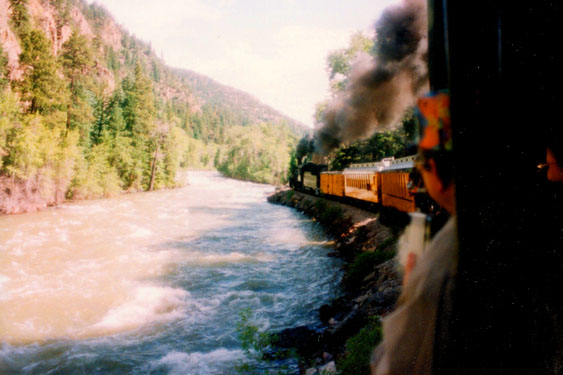 The Durango-Silverton train as it winds it way slowly upward along the Animas River. The train follows the river for most of the trip, getting higher and higher above it as it goes. |
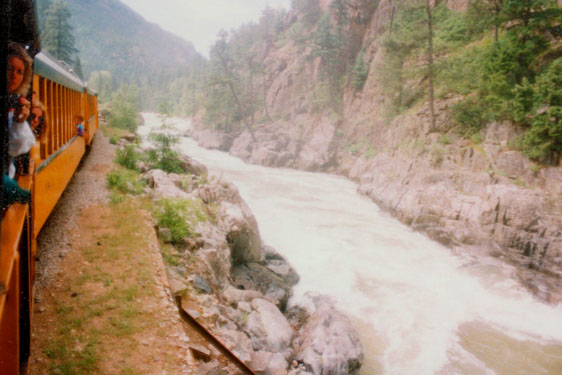 You can see here that the mountainsides are getting rockier, and that the train is getting higher above the surface of the river. Eventually, the river will be at the bottom of a very deep gorge. |
As the train proceeded, there were a number of places where we crossed the small streams and creeks that feed into the main river. Most have come down the steep mountainsides, so by the time we cross them, they are rushing along pretty quickly.
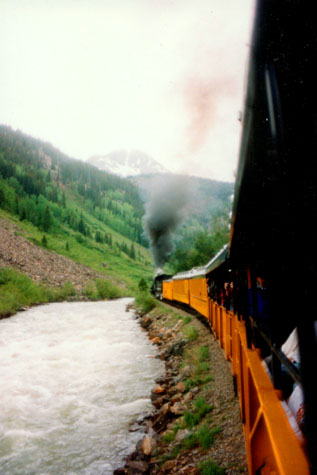 Along the Animas River |
(Picture at left) We left the riverside for a time, climbed through some meadows and then reached a level area again where we were beside the river. Shortly, though, the train began climbing again, and that's where the gorge gets really deep.
(Picture at right)
|
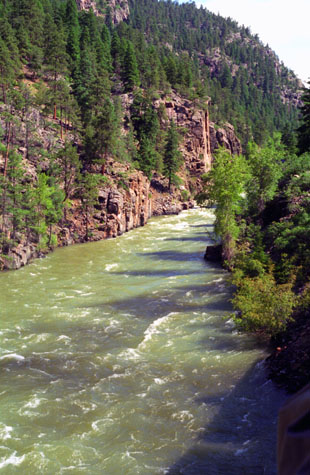 The Animas River Below |
The pattern of going alongside the Animas River for a while and then leaving it to climb through forested areas repeated for a half hour or so, although we never seemed to get much more than a thirty feet or so above the river- which was very pretty what with the mountain scenery and the rapids.
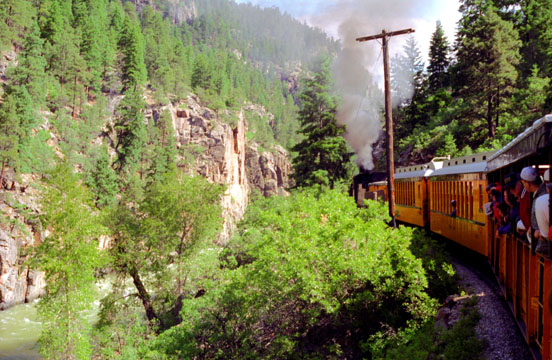 Above the Animas River The train has crossed to the other side of the river to continue its steady climb. It seemed as if this area was fairly level, but we were ascending. You can see the difference between the closed cars, which are like conventional railroad cars inside, and the open cars. |
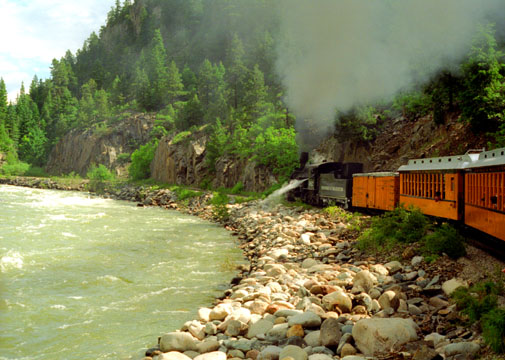 The Animas River Near Mile 470 At this point, we are on the same level as the river, having come through a gorge and then descended slightly into this valley. The engine is spraying water from the boilers, which is think is done to adjust the pressure in them. |
The open cars have two rows of seats, one on each side of the car facing out, with an aisle in the middle. This allows people to pass through the car without blocking your view. The train had a concession car, and there was a steady stream of people going back and forth to it.
|
This is a steam engine, of course, and while much of the water used is used over again, a certain amount escapes, and such trains have to take on water occasionally. There are also times when the engineer makes adjustments to the pressure in the boilers, and when he does that, he lets off steam. All this water has to be replaced.
Here at Needleton Tank, it is not the old wooden tank that you can see in the picture from which we got water; a new, more modern tank has replaced the one shown here, and you can't see it on the other side of the train. This old wooden tank was phased out over twenty years ago.
We are about 8300 feet high now, and can see lots of aspens, birches and alpine firs. We have also crossed a number of tributaries that feed the Animas, some of them doing so with waterfalls to the left or right of the train. We passed most of them so quickly that I couldn't get a decent picture, although I would have liked to.
On the way to this point, the river has been mostly on our side of the train, so we could get our pictures while sitting in our seats. From this point on, though, the train seemed to hug the cliff on our side, so we had to turn around or walk to the other side of the open car to get good pictures, which we did frequently. Fortunately, there were places to stand. The air is also becoming more chilly, and the weather seems to be deteriorating.
|
|
You can imagine how close the track must be to the edge of the canyon for me to take these shots. We have passed more creeks and streams, many with no names, that feed this river. We have also passed a couple of places where rockslides or erosion have destroyed the original track, and new track has had to be laid.
The weather continues to get chillier and there has been a bit of drizzle.
At one point we passed an old mine that you could see on the other side of the canyon, but it wouldn't have shown up well in a picture- except for the red/orange color of some of the tailings that could still be seen.
But now we come to the highlight of the entire trip. We noticed immediately that the train's pace slowed a bit as it came out of the forested area and wound out onto the "highline", a famous section of the railroad where the train crawls along the face of high cliffs.
|
There is not much I can add to the spectacular nature of the trip across the highline; here are two more pictures (which happen to have been taken on the way back from Silverton:
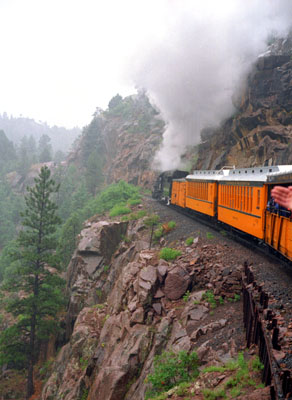 |
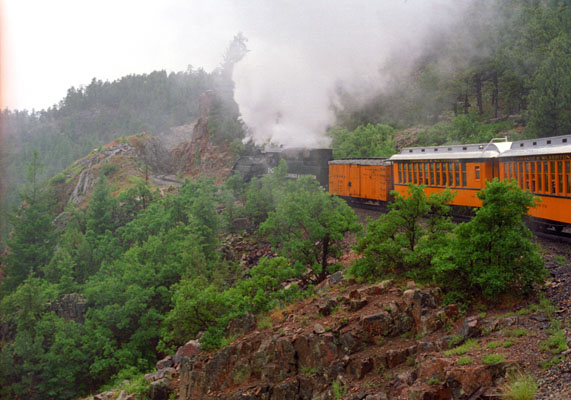 |
Before we leave the highline and begin our descent into Silverton, you may be interested to know that the Durango-Silverton Narrow Gauge Railway has been used in a number of movies, including "Butch Cassidy and the Sundance Kid" and "Support Your Local Gunfighter". The most extensive use was in the Jimmy Stewart Western from 1957 called "Night Passage". In this movie, about thirty minutes of the action takes place on the train, but there is a four-minute segment that shows Stewart and a youngster having a discussion while riding in an open rail car along the Animus and through the highline. If you watch the segment closely, you will see some of the same views of the Animus River and of the highline that you have seen in the pictures above. If nothing else, it is an interesting segment:
|
|
As we descended from the highline, we came back into more forested area, and came back down closer to the Animus River, where we have two more pictures that I want to include here:
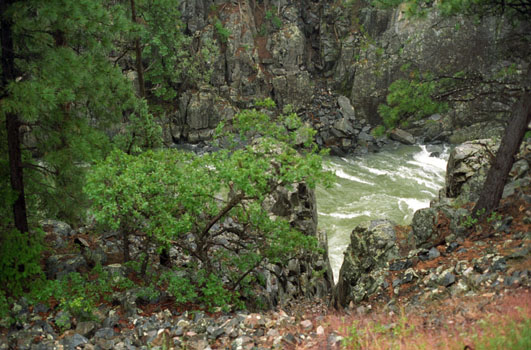 |
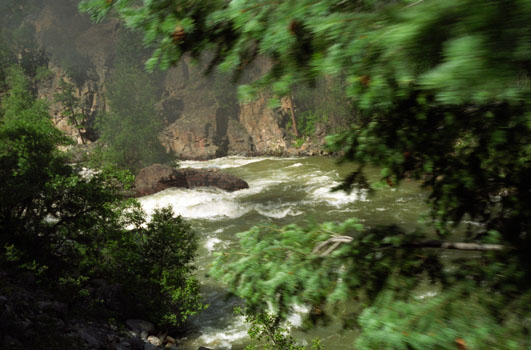 |
About a mile before we got into Silverton, we passed a beautiful waterfall coming down the rock slope on the other side of the Animus River. This was probably the most spectacular of all of the waterfalls that we passed, mostly because we had such a good view of it. The weather has definitely deteriorated as we have neared Silverton. It has gotten quite chilly and there is a drizzle.
Our Layover in Silverton
"What is a 'wye'"? you may ask? A wye, in rail terminology, is a triangular shaped arrangement of rail tracks with a switch or set of points at each corner. In mainline railroads, this can be used at a rail junction, where two rail lines join, in order to allow trains to pass from one line to the other line. Wyes can also be used for turning railway equipment. By performing the railway equivalent of a three-point turn, the direction of travel and the relative orientation of a locomotive or railway vehicle can be reversed, resulting in it facing in the direction from which it came. Where a wye is built specifically for reversing purposes, one or more of the tracks making up the junction will typically be a stub siding.
So how does this work? At Silverton, the entire train needs to be turned around before it heads back to Durango. While this can be done in a number of ways, the wye is the least space intensive for turning an entire train.
|
Railroad systems in North America and Australia have tended to have more wyes than railroads elsewhere. In Europe, although some use was made of bi-directional tank locomotives and push-pull trains, most steam locomotives were uni-directional. Because of land usage considerations, turntables were normally used to turn the locomotives, which were then attached to the opposite end of the original train. Over time, most diesel and electric locomotives ordered in Europe have been designed to be fully bi-directional, symmetrical, and normally with two driving cabs. Thus most turntables and, where they existed, rail wyes, have been taken out of use.
We took a couple of pictures as our train pulled into Silverton:
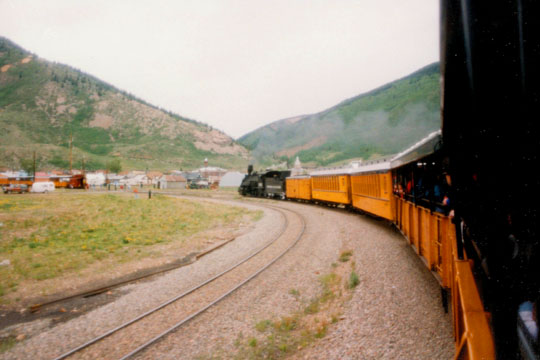 This is our train pulling into Silverton, mile marker 497. As we pulled into town, it started to rain and snow. The weather had been growing chillier, until now it was downright cold. All Fred had was my shirt, and I was wearing my jeans jacket. Both of us were quite cold. |
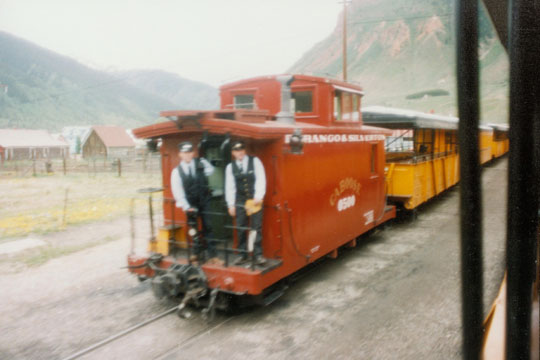 This is the rear of the train that had pulled into Silverton just before us. Silverton is about 9300 feet, so you can see we have climbed a good deal, and that is probably why the weather has gotten as bad as it is. We took almost no pictures as a result. |
Even though Fred and I were underdressed, we were, as it turned out, better off than many of the other tourists, some of whom were actually wearing shorts (and had definitely not come prepared). So, as chilly as we were, I guess we were better off than some.
|
Anyway, we got off the train, and made our way quickly to the warmth and shelter of a gift shop or two. The train ahead of us had been having some problems, so it arrived only a few minutes before we did. We found that this mattered when we tried to get some lunch- most of the eating places were already full as people from the earlier train had just started eating.
We were able to get high on the seating list at a restaurant in one of the oldest hotels in town, and it turned out that we had time to get a pretty good lunch. The weather outside was not improving, and as soon as we finished eating it was time to return to the train (since we had arrived late) for the return trip.
We found that the open car was soaking wet, and when we boarded we realized that it would not be possible to sit down as everything was so wet. So we just stood there, shivering, waiting for the train to start, when the conductor came through and suggested that we all take any available seats we could in the closed cars.
As it turned out, Fred and I were able to get seats behind each other in the closed car right next to ours (the occupants of those seats having taken the bus back to Durango, which can be done for an extra charge). Unfortunately, being in the closed car meant that picture taking would not be possible, but if one got up periodically and went to the open car, which I did when we got far enough along the trip back so that the rain and snow had tapered off, there were some good views.
Fred stayed in the closed car most of the time; I know him well enough to know that he was not enjoying the trip back, and felt that somehow he had not planned correctly and was disappointed in the way things were turning out. As the weather improved on the way back, though, so did his outlook, until we were both back out in the open car, in the sunshine that had returned by the time we got close to the valley where Durango is.
Anyway, the next few pictures on the way back are OK, I guess, but they would have been a lot better had the weather cooperated. I can't complain though; in all the trips we have taken, this is the first time that weather has materially affected our travels.
The Return to Durango
|
I think Fred was glad to get out of the closed car; it was stuffy in there, and the fogging of the windows didn't allow good sightseeing. I know that Fred was definitely disappointed in how the weather had turned out. He was in the mindset of thinking that since he'd advised that we take this trip, then that meant he was somehow responsible if things weren't perfect. And I know he was comparing how things had gone today with how they had gone years ago when he and Frank Roberts made the same trek.
I was at pains to point out that he was just trying to compare this trip with that one, but that nothing is ever just as good or just as bad as you remember it.
Although the part of the trip in and out of Silverton wasn't very scenic what with the poor weather, and even though it might have been nicer had it been a sunny afternoon for our layover there, still and all the entire trip was very much an experience that I was glad to have had. I was not at all disappointed in the trip and I was glad that Fred had suggested it.
|
By the time we got back into town, the sun was fully out and the air was warming up. Indeed, if we stood in the sunlight (which we tried to do as much as possible) it was a very pleasant afternoon. I guess the change in weather from these lower elevations to the higher elevations of Silverton is normal at this time of year, but by the time we got to the depot in Durango, the sky was almost clear.
It's too bad that the weather didn't cooperate fully, but all in all I had a great time even though Fred was somewhat disappointed. We returned to the depot about five in the afternoon, and went up the street to where we had parked the truck.
|
As we drove, the weather again took a turn for the worse, and by the time we reached Navajo Lake it was raining lightly. We stopped at the dam below which the campgrounds are situated, and decided that it wasn't worth trying to set the tent up in the rain, or camping if we knew the weather would be bad, since one of the things we liked to do was cook, and you would find that impossible if the rain continued.
We decided to push on across the dam and just get a motel room in Bloomfield for the night. So we continued south on New Mexico Highway 511 to US Highway 64 and then headed west the fifteen miles into Bloomfield. Driving towards Bloomfield, the weather again began to clear up, and we thought again about camping. But it was getting late and we thought that any campsite we might find would be wet and muddy. We concluded, reluctantly, that we would just stay overnight in Bloomfield.
|
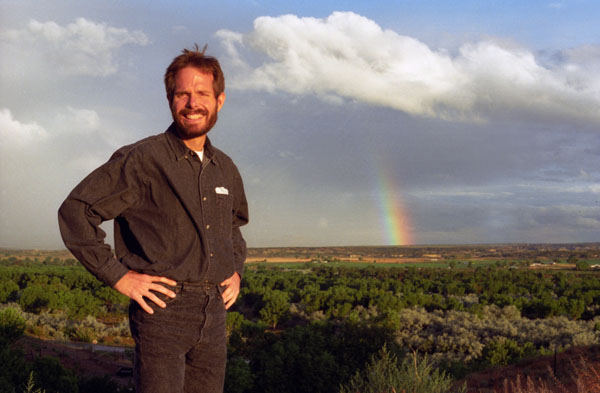 |
We made our way into Bloomfield, and stopped at the Super 8 Motel at the same intersection where we had gassed up the day before. There weren't many places to eat in Bloomfield, and we decided just to make sandwiches in the room. I think Fred was still disappointed by the day, as he seemed a bit down all evening. We spent some time planning our activities for the next day, watched some television, and went to sleep.
You can use the links below to continue to another photo album page.
 |
July 4, 1995: Hiking in the Jemez Mountains |
 |
July 2, 1995: Chaco Canyon: Pueblo del Arroyo and Pueblo Alto |
 |
Return to the Index for Our Western Trip |